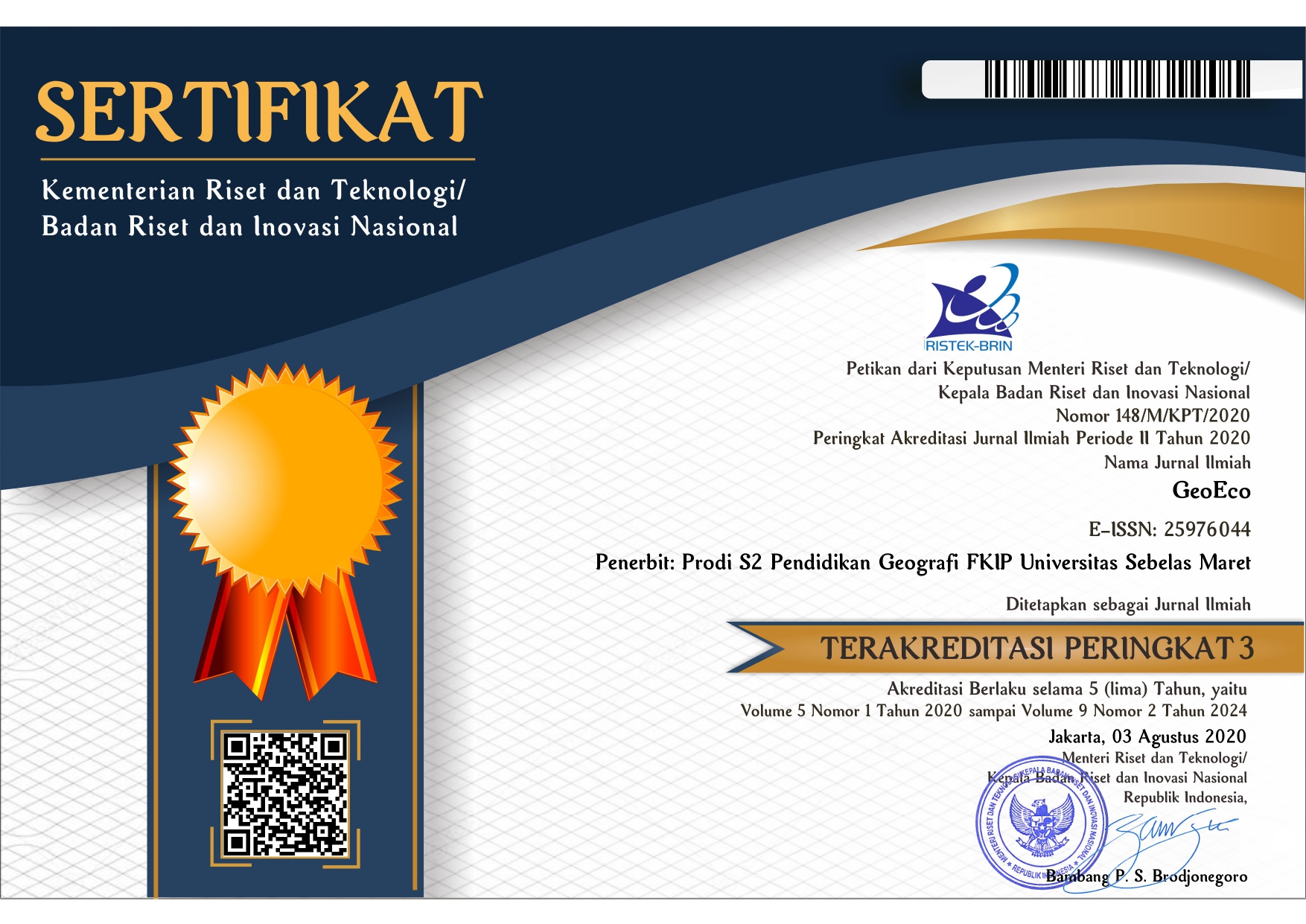OPTIMAL BENCH MARK DISTRIBUTION TO MONITOR SOUTHERN SEGMENT OF SUMATRAN FAULT
Abstract
The southern segment of a Sumatran fault zone was one of the sources of earthquakes in Lampung Province. The source of hazard came from stress accumulation of crust, which can be derived from movement of bench mark in surface. Lack of research in southern segment was caused by small numbers of monitoring bench mark. This research shown optimal monitoring bench mark distribution by considering existing bench mark and location which is decent and representative to monitor Sumatran Fault Zone movement by considering on its position relative to Sumatran Fault Zone, earthquake history, Digital Elevation Model and land use. Decent location was determined by overlaying land use and slope processed from Digital Elevation Model. Representative location was determined by taking into account the distance to Sumatran Fault Zone and earthquake history. Very decent location is around 10.5 percent of the total area. Very representative location is around 44.5 percent of the total area. There are total 15 planned bench marks location to make southern Segment of Sumatran Fault Zone monitoring bench mark more optimal.
Keywords
Full Text:
PDFReferences
Alif, S. M., Meilano, I., Gunawan, E. & Efendi, J. (2016). Evidence of Postseismic Deformation Signal of the 2007 M8.5 Bengkulu Earthquake and the 2012 M8.6 Indian Ocean Earthquake in Southern Sumatra, Indonesia, Based on GPS Data. Journal of Applied Geodesy, doi: 10.1515/jag-2015-0019 Alif, S. M., Pratama, A. (2019). Analysis of Southern Segment of Sumatran Fault Monitoring Bench Mark as Preliminary Approach in Updating Earthquake Hazard Map. Journal of Science and Applicative Technology, [S.l.], v. 2, n. 1, p. 183 - 191, doi: https://doi.org/10.35472/281470. Beon, M. L. (2008) Slip rate and locking depth from GPS profiles across the southern Journal of Geophysical Research Bradley, K. E., L. Feng, E.M. Hill, D. H. Natawidjaja, and K. Sieh (2017) Implications of the diffuse deformation of the Indian Ocean lithosphere for slip partitioning of oblique plate convergence in Sumatra J. Geophys. Res. Solid Earth 122 572–591 doi: 10.1002/ 2016JB013549 Duggal, N. (2007) Retail Location Analysis: A Case Study of Burger King & McDonald’s in Portage & Summit Counties, Ohio Kent: Department of Geography, University of Kent Floyd, R. P. (1980). Stable and Enduring Monuments for Vertical Control Networks. International Hydrographic Review. LVII (1):77-86 Gatto, L.W. (1987). Benchmark Design and Installation: A Synthesis of Existing Information. Special Report 87-10. US Army Corps of Engineers Lindsey, EO, Fialko, Y. (2013) Geodetic slip rates in the southern San Andreas Fault system: Effects of elastic heterogeneity and fault geometry Journal of Geophysical Research-Solid Earth 118:689-697 McCaffrey, R. (2009). The Tectonic Framework of the Sumatran Subduction Zone. Annual Reiew of Earth and Planet Sciences, 37:345-366. NPS-URI. (2019). Guidelines For Installation Of Backbone Survey Monuments On NPS Lands. [Internet Document]. [diakses 28.06.2019]. Situs: http://www.edc.uri.edu/monumentation/protocols/ URI_NPS_Guidelines_for_monument_install.pdf Sieh, K. and Natawidjaja, D. (2000) Neotectonics of the Sumatran fault, Indonesia Journal of Geophysical Research 105 28 295-28 326 USGS. (2019). General Information [Internet document] [accessed on 18.08.2019] Site: http://earthquake.usgs.gov/earthquakes/search/
Refbacks
- There are currently no refbacks.












.png)

